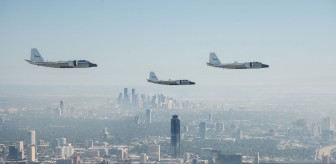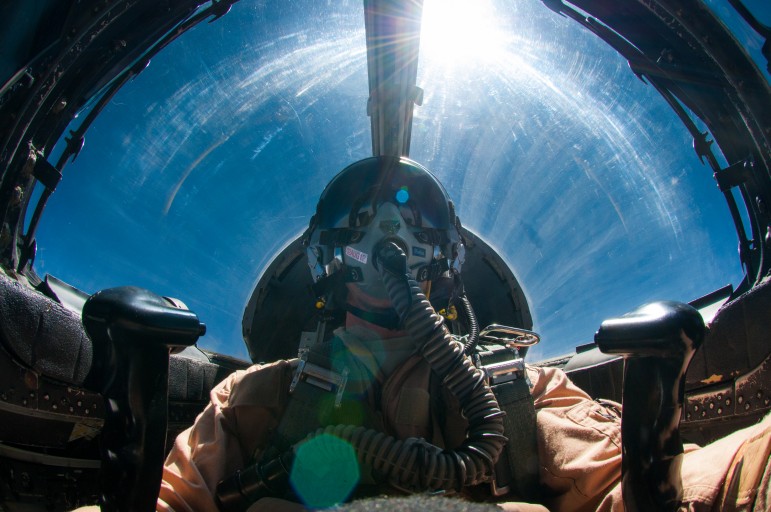High Technology Could Solve Solar Mysteries During Eclipse
Millions of Americans will see Monday’s solar eclipse, but besides the delight and awe that comes with such a big, cosmic event, it could yield important new measurements and a better understanding of our solar system. Cutting-edge imaging technology from a Birmingham-based nonprofit is set to fly along the eclipse’s path on two former military planes now operated by NASA.
Window (or Shadow) of Advantage
Normally, the sun is so bright and hot it makes studying anything near it difficult. But Birmingham’s Southern Research is taking advantage of the eclipse. Don Darrow of NASA and Southern Research says even with the best heat-imaging cameras, it’s hard to get a read on Mercury, the planet closest to the sun. It’s complicated, but he says, “basically, it’s too hot to be able to get accurate measurements through infrared. So this opportunity that we have, with the moon blocking it out — we’ll actually be able to get the first temperature gradients of Mercury that have been recorded.”
Temperature maps of Mercury won’t be the only goal when Darrow and an engineer in another retooled B-57 bomber start chasing the moon’s shadow south of Saint Louis. High-resolution images and video could help scientists solve a mystery at the center of our solar system.
“The intention is to try to identify why the outer layers of the sun are so much hotter than some of the inner layers,” he says.
And there’s yet another puzzle that Southern Research’s imaging system could resolve: whether asteroids called vulcanoids near Mercury exist. Astronomers think they might, but small objects close to the sun are hard to detect.
No Pressure at All
The telescopic cameras will try to find these objects and more from almost 10 miles above the Earth.
“We have a joystick in the back, like you’d see in the cockpit of an airplane. That’s how we manually control the sensors,” he says, adding, “There’s a lot that can go wrong. And I have to be on my game in order to make sure that I can either head off anything that I see coming, or overcome anything that happens.”
The Need for Speed
Down on the ground in Birmingham, Southern Research engineering project director Johanna Lewis says the eclipse moves really fast, so they have a strategy: two planes.
“One will fly with the shadow, but the shadow moves faster than the plane moves,” she explains. “So we’ll be able to get about four minutes of data out of the first plane. The second plane will come in and pick up where it left off and collect another four minutes. And so we’ll be able to stretch that to about eight minutes worth of data.”
That’s eight minutes of eclipse when the sun won’t overpower or damage the sensors. Lewis has faith in the mission team, too:
“NASA provides the planes, Southern Research provides the instruments that collect the data, and [Texas-based nonprofit] Southwest Research will be processing the data and doing the analysis.”
Some of those findings could be released in about a month. Darrow sees many potential benefits here.
“This mission is going to be historic for the Mercury observation, but I think we’re going to get some phenomenal images of the sun as well.”
Those images are set to be live-streamed on NASA TV. And you won’t even need special glasses or a modified B-57 bomber to see them.
Supreme Court lets Texas use gerrymandered map that could give GOP 5 more House seats
The Supreme Court has cleared the way for a Texas congressional map that may help the GOP win five more U.S. House seats in the 2026 midterms. A lower court found the map is likely unconstitutional.
State Department to deny visas to fact checkers and others, citing ‘censorship’
The order is focused on applicants for H-1B visas, which are frequently used by tech companies and is part of a campaign by the Trump administration against online content moderation.
Libraries and museums get federal funding back after Trump cuts
Earlier this year, the Trump administration gutted the Institute of Museum and Library Services, leading to canceled federal grants. Now, after a court order, those grants are being reinstated.
You read that white: Pantone’s 2026 Color of the Year is ‘Cloud Dancer’
This is the first time Pantone has chosen a shade of white. The company says it's "a lofty white that serves as a symbol of calming influence in a society rediscovering the value of quiet reflection."
CDC advisers delay planned vote on hepatitis B vaccine for infants
After a contentious discussion, the vaccine advisory group pushed the vote to Friday to give members time to study the language of proposed changes longstanding policy on the shots.
DOJ orders prison inspectors to stop considering LGBTQ safety standards
A memo obtained by NPR shows the Justice Department is telling inspectors to stop evaluating prisons using standards designed to protect trans and other LGBTQ community members from sexual violence.









